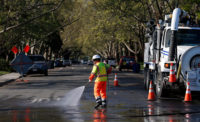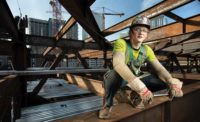A committee of the Centers for Disease Control and Prevention issued guidelines on Dec. 20 that suggest construction workers receive coronavirus vaccine shots in the program rollout's third phase, after they are provided in earlier stages to the elderly and to healthcare and other "frontline" essential workers.
The third phase could start from February to late spring 2021 if the vaccination program goes smoothly.
The guidelines, built on federal classifications for essential workers created earlier in the pandemic, are believed to cover all types of construction workers, regardless of project or trade, said Brian Turmail, a spokesman for the Associated General Contractors.
AGC had clarified the point with CDC on Dec. 21 after an agency presentation on the rollout guidelines the day before seemed to indicate that only construction workers employed on housing and shelter-related projects belong in the third phase.
"We checked with them and CDC staff indicated the words shelter and housing were given only as examples and that the prior classification of all construction workers as essential was intended," said Turmail.
In general, states and cities will determine the order in which vaccines created to prevent COVID-19 will be provided,
Early in the pandemic, nearly every state governor issued executive orders that outlined industries deemed “essential” during the pandemic, "which typically include health care, food service, and public transportation, among others," according to the Economic Policy Institute, a think-tank that advocates for low- and middle-income workers.
But during the pandemic, state and local officials and employers often used federal CDC guidelines as a baseline and reference to create rules for face coverings, social distancing and other safety practices.
The federal government recently suggested, and labor attorneys have said, that in general employers may require vaccination as a condition of employment.
Occupations that get priority for vaccination may return more quickly to normal functioning.
Kathleen Dooling, a CDC chief medical officer and member of its advisory committee on immunization practices, said in a presentation that the committee had to balance preventing illness and death, on one hand, with preserving the smooth functioning of society, on the other.
In the first two phases of the vaccine rollout, the committee recommended, doses should be given to the elderly, frontline-essential workers in health care and people with underlying conditions such as heart disease or diabetes.
Following classifications of essential workers made by the Cybersecurity & Infrastructure Security Agency, the CDC advisory committee said that construction workers of all types belong in a third phase. That group also includes engineers involved in public safety, as well as people employed in water and wastewater treatment systems and in transportation and logistics.
While most construction work has continued during the pandemic, virus clusters and government orders have shut down some work for several days or weeks. Health data studied by scientists have indicated that construction jobsites can contribute to local outbreaks. There have been some projects, such as Allegiant Stadium in Las Vegas, SoFi stadium in Los Angeles, where dozens of workers tested positive.
The biggest known construction cluster, at the Plant Vogtle nuclear reactor project in Georgia, is believed to have involved at least 800 workers who tested positive for the virus. Most returned to work.
This story was updated Dec. 21 to reflect that CDC considers all construction workers to be essential workers.






Post a comment to this article
Report Abusive Comment